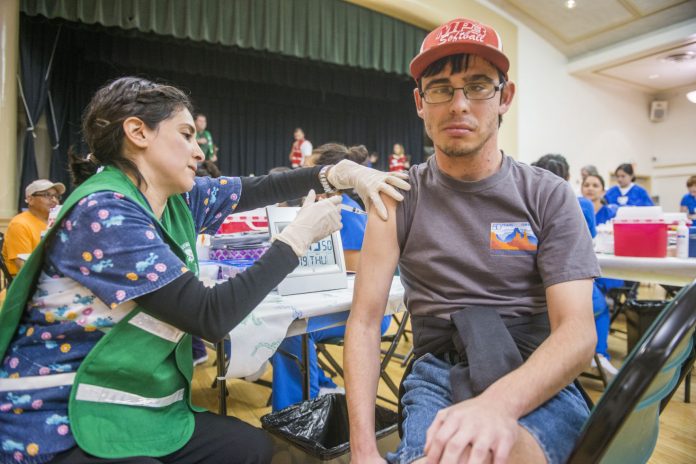
We are fast approaching the peak of flu season. While the “flu season” officially started in October and can run through May, the peak for California is anticipated to be February.
Influenza, or flu, is a contagious respiratory illness caused by influenza viruses. It can be a mild to severe illness and at times lead to death. The best way to prevent influenza is by getting a flu vaccination each year. There are three types of influenza viruses: A, B and C. Human Influenza A and B viruses cause seasonal epidemics of disease almost every winter in the United States. Influenza C causes a very mild respiratory illness and is not thought to cause epidemics. The current vaccination covers both A and B viruses.
The CDC recommends a yearly vaccination for 6 months of age and older as the first and paramount step in protecting yourself against the flu. Vaccines became available in October 2015, and it is recommended that you get your vaccinations early to minimize the chance of exposure to the flu. However, as long as flu season persists, it is never too late to vaccinate. It takes approximately two weeks for the vaccination to build immunity in your body against the flu viruses. Therefore, this is a great time to get the vaccine if you haven’t already. Each year the flu virus mutates (changes) so the vaccine is adapted to treat the current flu virus strain. As a result, you cannot depend on your vaccination from a previous year to afford protection against the current flu. Call your provider, local clinics, pharmacy or Public Health Services for a vaccination today.
If you do get sick, especially if you are a member of a group considered to be high risk (e.g. two years old and younger, 65 years and older, pregnant women, immune system-compromised persons and those living in a long-term care facilities), please seek appropriate care immediately. The symptoms of the flu are fever over 100° F (38° C); muscle aches, especially in the back, arms and legs; chills and sweats; headache; dry, persistent cough; fatigue and weakness; nasal congestion; and sore throat. The treatment for the flu is antiviral medications and rest. It is recommended that those at high risk for complications start the antiviral treatment within 48 hours of the onset of flu symptoms to decrease length and severity of flu. This can minimize duration and severity of the illness and potentially prevent hospitalization.
In addition to the protection afforded by the flu vaccination, other important measures you should take to minimize the risk of contracting the flu or infecting others if you have acquired the infection include:
• Avoid close contact with people who are sick.
• Stay home from work or school if you are sick.
• Cover your nose and mouth with a tissue when sneezing and coughing.
• Wash hands often with soap and water, avoid touching your nose, eyes and mouth.
• Clean and disinfect frequently touched surfaces at home, work and school.
• Practice good health habits by getting plenty of sleep, staying physically active, managing stress, drinking plenty of fluids, and eating nutritious foods. Foods high in sugar are actually known to decrease the immune system.
We are currently entering Week 53 of the “flu season” and the latest report from the California Department of Public Health (CACDC) indicates that influenza activity in California is beginning to increase. A “snapshot” of the latest influenza activity for this past surveillance week includes the following:
Outpatient influenza-like illness (ILI)—The number of visits as a percentage of total outpatient visits for ILI is above anticipated levels for this time of year. ILI visits Increased to comprise 3.7% of total outpatient visits during Week 52, which amounts to a 23% increase from the previous Week 51 (3.0%).
Hospitalization data- 6.4% of Kaiser patients hospitalized during Week 52 were admitted with a pneumonia and/or influenza (P&I) diagnosis. Although this represents a 12% increase from the previous week, the percentage of P&I admissions is within expected levels for this time of year.
Influenza virus detection by Respiratory Laboratory and Sentinel Laboratories- Of the total reported specimens tested for influenza, 5.4% were positive during Week 52, which represents an increase of 17% compared to week 51 (4.6%).
Influenza related deaths among patients 0-64 years of age- No laboratory-confirmed influenza deaths were reported during Week 52.
Influenza-associated outbreaks- No laboratory-confirmed outbreaks were reported during Week 52.
The data demonstrate an escalation in the incidence of the flu and associated healthcare visits. We urge you to protect yourself and your family from this illness by following all of the measures listed above. We also recommend that you take time to educate yourself and answer any additional questions utilizing the resources noted below. Take care and stay well this flu season.
If you have any questions about this article please call San Benito Public Health Services at (831) 637-5367. For more information visit, www.cdc.gov, www.cdph.ca.gov, or http://eziz.org/vfc/provider-locations.
Sonnenschein submitted this through the San Benito County Public Health Department, which runs regular columns in the Free Lance.









